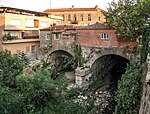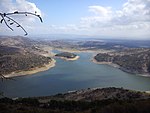Battle of Bergama
1919 in Greece1919 in the Ottoman EmpireBattles in 1919Battles of the Greco-Turkish War (1919–1922)Bergama ... and 2 more
Conflicts in 1919June 1919 events

The Battle of Bergama was fought at and near Bergama (ancient Pergamon, now a district center of İzmir Province, Turkey) between the Greek army and forces of the nascent Turkish National Movement (Kuva-yi Milliye) during the Greco-Turkish War of 1919–1922. The Turkish forces pushed the Greek army from Bergama on 15 June, but the town was recaptured on 22 June.
Excerpt from the Wikipedia article Battle of Bergama (License: CC BY-SA 3.0, Authors, Images).Battle of Bergama
Adnan Menderes Bulvarı,
Geographical coordinates (GPS) Address Nearby Places Show on map
Geographical coordinates (GPS)
| Latitude | Longitude |
|---|---|
| N 39.116666666667 ° | E 27.2 ° |
Address
Adnan Menderes Bulvarı
Adnan Menderes Bulvarı
35700 , İslamsaray Mahallesi
Turkey
Open on Google Maps








